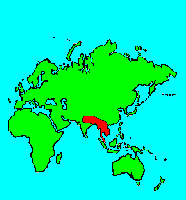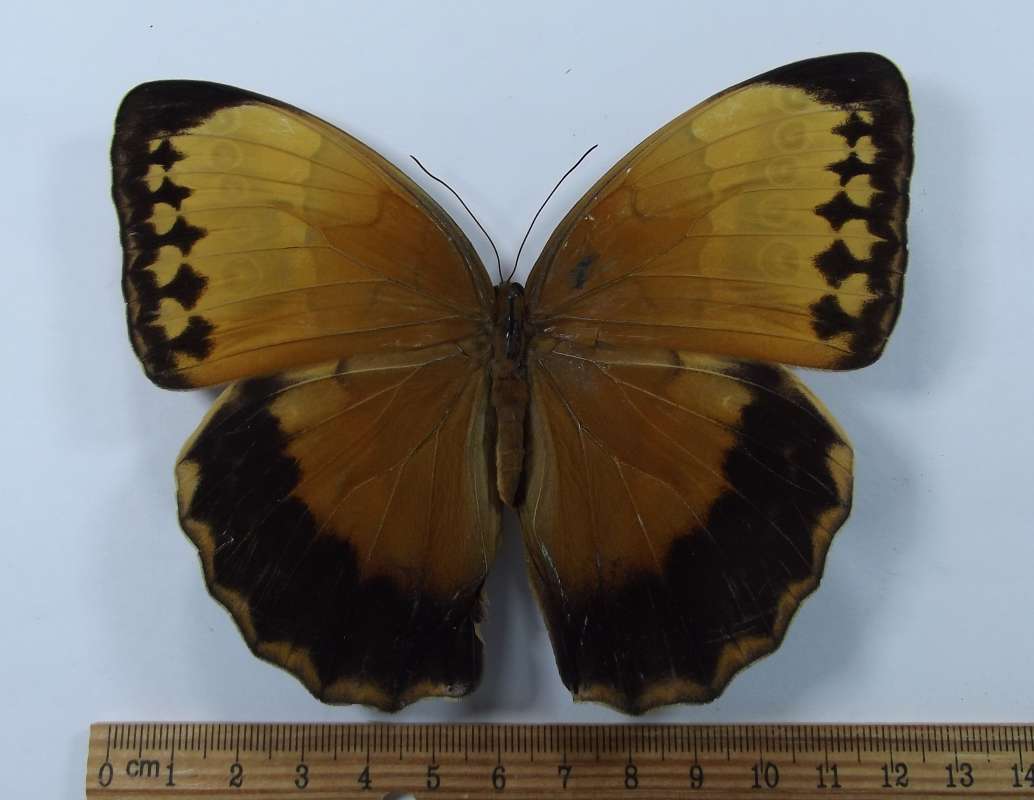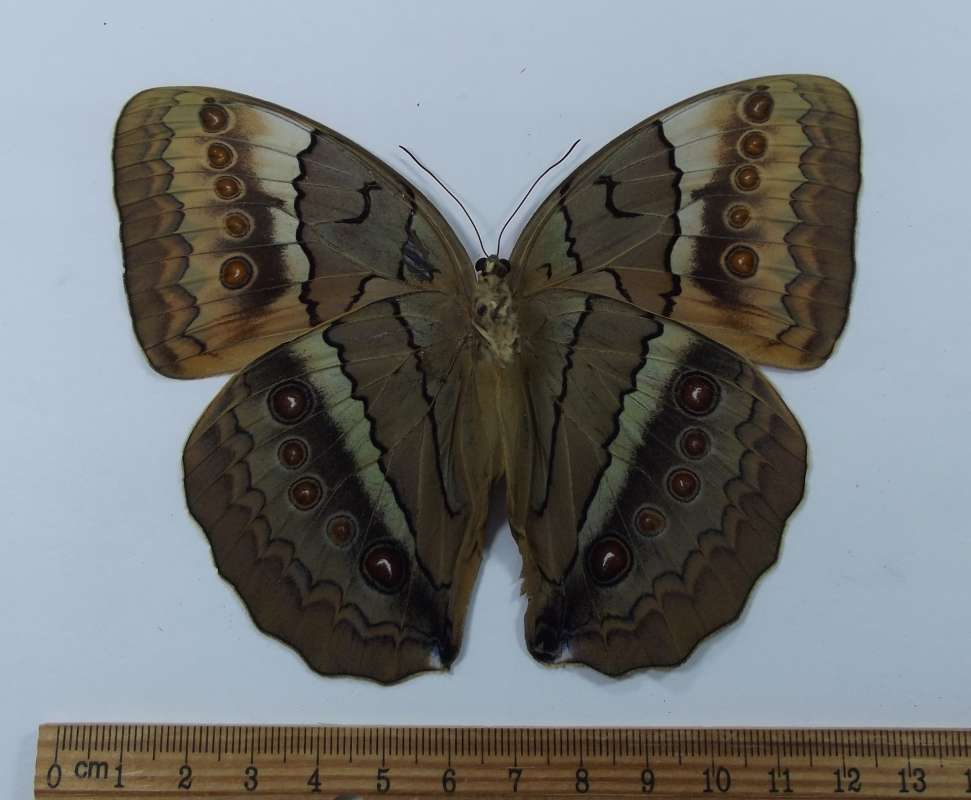SPECIES INFO
Stichopthalma sparta can be found in Burma (Myanmar) east into northern Yunnan in China. This species is rarely collected. Stichopthalma sparta was described by deNiceville in 1894. We include this male, as the data is more precise, and it might be of interest.Stichopthalma genus is found primarily in the southern mainland of Asia. These can be large and spectacular butterflies. Some of the females can be very large. These butterflies fall into two different groups: those with purple and blue markings on the dorsal side and those with primarily yellow dorsal sides.
Following is a list originated from Paul Smart. Ranges, comments, and species have been added later from various sources:
Stichopthalma howqua - China, Vietnam, Taiwan (orange, black markings)
Stichopthalma neomogeni - China into Vietnam (orange with black markings)
Stichopthalma camadeva - northern India (blue patterns)
Stichopthalma fruhstoferi - Indo-China (Orange-white pattern)
Stichopthalma louisa - India and Thailand (orange and white pattern)
Stichopthalma nourmahal - northern India into Burma (small - orange brown)
Stichopthalma editha - Cambodia - Thailand and Indo China ( blue pattern) - Syn-Ssp of S. cambodia
Stichopthalma godfreyi - Burma (orange-blue)
Stichopthalma sparta - northern India into Burma (orange marked with black)
Stichopthalma tyleri (near S. sparta) -
Stichopthalma uemurai - Vietnam - Blue and Black
We have found the 26 Stichopthalma images in Pisuth EK-Amnuay (Butterflies of Thailand) the greatest help in attempting to understand the complex taxonomy of this genus in SE Asia.
The orange Stichopthalma group is found from southern and central China west to SE Asia and north India and south to Borneo. The discovery of various forms in central Vietnam has opened up the taxonomy of the whole group. Stichopthalma howqua, Stichopthalma suffusa, Stichopthalma japetus, and potentially other forms belong here.
In 1985 D'Abrera showed S. sparta (a full species) of NE Burma and Assam with a white area near the dorsal outer tip of the forewing. He showed S. howqua japetus from South Vietnam and S. howqua tonkiniana from North Vietnam with large dorsal black spots in rear wing.
In 2011 Monastyrskii in Volume 3 of the Butterflies of Vietnam showed S. howqua japetus dorsal (similar to typical S. howqua) and Stichopthalma suffusa tonkiniana with very dark marginal giant rear wing spots on the rear wing. His S. japetus has ventral spots on front wing 3 and 4 very weak. His S. howqua suffusa has all five ventral spots clearly marked.
In Butterflies of Thailand (2012) 2nd revised edition by EK-Amnuay shows S. howqua tonkiniana with 5 full ventral spots dorsal side like typical howqua.
Amathusidae Family is a family of perhaps eighty species of medium and large-sized butterflies. The family is closely related to the Morphodae of South America. The Amathusids are found from India through Malaysia and Indonesia to New Guinea and the Solomon Islands. Generally, the butterflies have relatively small bodies for their wing size and frequently have ocelli (eyespots) on the underside of their wings. In the genus Zeuxidea, there is marked sexual dimorphism as the females are very unlike their corresponding mates.
During the years 2000-2016 numerous lifeforms have been discovered in Vietnam. Many of these discoveries have lead to confusion and contradictions with the taxonomy. This is especially true with the genus Stichopthalma. To help unravel this situation, we have divided this family in several groups, hopefully placing similar species near each other:
Taenaris and M-taenaris - New Guinea area
Stich. orange - China, Mnts southward
Stich. orange & small - China and west
Stich. louisa, cambodia, and fruhstorferi - India, SE Asia
Stich. camadeva and relatives
Stich. godfreyi and relatives
Stich. uemurai and all its forms
Amathuxidea and Zeuxidea - SE Asia to Malaysia, Java
Everything else
Butterflies and Moths (Order Lepidoptera) are a group of insects with four large wings. They go through various life cycles including eggs, caterpillar (larvae), pupae, and adult. Most butterflies and moths feed as adults, but primarily do most of their growing in the larval or caterpillar stage. Also, most species are restricted to feeding as caterpillars upon a unique set of plants. In this pairing of insects to plants, there arises a unique plant population control system. When one plant species becomes too common, specific pests to that species also become more common and thus prevent the further spreading of that particular plant species.
Although most people think of the Lepidoptera as two different groups: butterflies and moths, technically, the concept is not valid.
Some families, such as Silk Moths (Saturnidae) and Hawk Moths (Sphingidae), are clearly moths. Other families, such as Swallowtail Butterflies (Papilionidae), are clearly butterflies, However, several families exhibit characteristics that appear to be neither moths nor butterflies. For example: the Castnia Moths of South America are frequently placed in the Skipper Family (Hesperidae). The Sunset Moths (Uranidae) have long narrow antennae and fly during the day.
The Saturnidae (Silk Moths) and Papilionidae (Swallowtails) are two Lepidoptera families that have been very carefully researched as to species and subspecies. The current thinking is that if the male genitalia are alike, then the two specimens belong to the same species. As an amateur, your editor disagrees with this premise. If the genitalia are different, then no doubt two species are involved. However, if the genitalia are alike, it only proves that the genitalia are alike.
Consider Papilio multicaudata which is found in southern Canada at higher altitudes. Papilio multicaudata is found south through the Rocky Mountains as far south as Mexico City, and recently as far south as Guatemala. With different food plants, different soil types, different climates, and different seasonal patterns, it is hard to believe that this complex is all one species.
Consider capturing 100 living individuals at any life stage in Guatemala and then carrying them north to southern Canada. Would these individuals survive through several generations. If they would not survive, then this author would conclude that two different species are involved!
In the Saturnidae consider Eacles imperialis subspecies pini. This life form feeds on pines. Is not this sufficient to justify a full species status?
Note: Numerous museums and biologists have loaned specimens to be photographed for this project.
Insects (Class Insecta) are the most successful animals on Earth if success is measured by the number of species or the total number of living organisms. This class contains more than a million species, of which North America has approximately 100,000. (Recent estimates place the number of worldwide species at four to six million.)
Insects have an exoskeleton. The body is divided into three parts. The foremost part, the head, usually bears two antennae. The middle part, the thorax, has six legs and usually four wings. The last part, the abdomen, is used for breathing and reproduction.
Although different taxonomists divide the insects differently, about thirty-five different orders are included in most of the systems.
The following abbreviated list identifies some common orders of the many different orders of insects discussed herein:
Odonata: - Dragon and Damsel Flies
Orthoptera: - Grasshoppers and Mantids
Homoptera: - Cicadas and Misc. Hoppers
Diptera: - Flies and Mosquitoes
Hymenoptera: - Ants, Wasps, and Bees
Lepidoptera: - Butterflies and Moths
Coleoptera: - Beetles
Jointed Legged Animals (Phylum Arthropoda) make up the largest phylum. There are probably more than one million different species of arthropods known to science. It is also the most successful animal phylum in terms of the total number of living organisms.
Butterflies, beetles, grasshoppers, various insects, spiders, and crabs are well-known arthropods.
The phylum is usually broken into the following five main classes:
Arachnida: - Spiders and Scorpions
Crustacea: - Crabs and Crayfish
Chilopoda: - Centipedes
Diplopoda: - Millipedes
Insecta: - Insects
There are several other "rare" classes in the arthropods that should be mentioned. A more formal list is as follows:
Sub Phylum Chelicerata
C. Arachnida: - Spiders and scorpions
C. Pycnogonida: - Sea spiders (500 species)
C. Merostomata: - Mostly fossil species
Sub Phylum Mandibulata
C. Crustacea: - Crabs and crayfish
Myriapod Group
C. Chilopoda: - Centipedes
C. Diplopoda: - Millipedes
C. Pauropoda: - Tiny millipede-like
C. Symphyla: - Garden centipedes
Insect Group
C. Insecta: - Insects
The above list does not include some extinct classes of Arthropods such as the Trilobites.
Animal Kingdom contains numerous organisms that feed on other animals or plants. Included in the animal kingdom are the lower marine invertebrates such as sponges and corals, the jointed legged animals such as insects and spiders, and the backboned animals such as fish, amphibians, reptiles, birds, and mammals.



